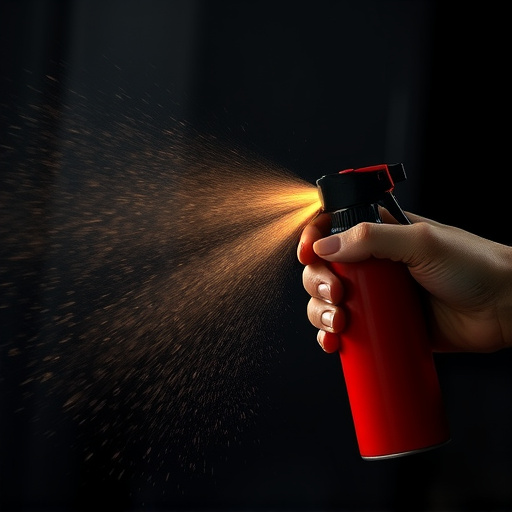Using pepper spray safely involves understanding its types, distances, and legalities. Choose the right formula for threat scenarios, store it securely, and follow guidelines for deployment. Only use as a last resort, targeting eyes and nose at safe distances, while adhering to local laws and bystander safety. Misuse carries penalties; always check regulations before carrying or using pepper spray.
In today’s world, personal protection devices like pepper spray are crucial tools for self-defense. Understanding chemical irritants, specifically pepper spray, involves weighing the benefits of its immediate effectiveness against potential risks and drawbacks. This article guides you through the essentials, from the science behind pepper spray to safe handling practices, legal considerations, and optimal use cases. Learn when to deploy pepper spray safely to ensure your protection without compromising safety.
- Understanding Chemical Irritants: Benefits and Risks
- Pepper Spray: Types and Effective Distance
- Safe Handling Practices for Optimal Protection
- Situations Requiring Pepper Spray Intervention
- Legal Considerations: Use and Possession Guidelines
Understanding Chemical Irritants: Benefits and Risks
Chemical irritants, like pepper spray, have become essential components of personal protection devices. These substances are designed to cause temporary discomfort or pain when deployed against potential threats, enabling users to escape or incapacitate assailants. The primary benefit lies in their non-lethal nature, making them valuable tools for self-defense in various scenarios, from everyday walks to high-risk professions.
However, the use of chemical irritants comes with risks. Exposure can lead to respiratory distress, skin irritation, and other health issues, especially in individuals with pre-existing conditions or when used in enclosed spaces. Therefore, it’s crucial to understand the dynamics of these substances and their safe application. When used responsibly, following guidelines like those provided by manufacturers for pepper spray, they offer a powerful tool for enhancing personal safety without undue harm.
Pepper Spray: Types and Effective Distance
Pepper spray, a common chemical irritant used in personal protection devices, comes in various types designed for different purposes and environments. While all pepper sprays aim to cause temporary blindness and respiratory distress in the target, key differences lie in their formulation, concentration, and effective distance.
The effective distance of pepper spray can range from 20 feet (6 meters) to over 100 feet (30 meters), depending on the brand and model. While a shorter-range spray might be suitable for close encounters, longer-range options offer more protection in open spaces or when facing multiple attackers. When to use pepper spray safely involves understanding these variations and choosing a spray that aligns with potential threat scenarios. Users should also familiarize themselves with local laws and regulations regarding the carrying and usage of pepper spray to ensure its application is legal and appropriate.
Safe Handling Practices for Optimal Protection
When using pepper spray as a personal protection device, adhering to safe handling practices is paramount for optimal protection. It’s crucial to store the spray in a cool, dry place away from direct sunlight and extreme temperatures. Keep it out of reach of children and pets, using childproof containers where necessary. Always inspect the nozzle for any damage before each use, ensuring the cap is securely fastened when not in use to prevent accidental discharge.
To ensure safety while deploying pepper spray, only use it when absolutely necessary for self-defense. Avoid aiming it at eyes or face unless absolutely required, as it can cause temporary blindness and significant discomfort. Keep a safe distance from the assailant, typically 2–3 meters (6–10 feet), to minimize cross-contamination. After use, wash your hands thoroughly with soap and water, and launder any clothing that may have come into contact with the spray to prevent skin irritation or potential inhalation.
Situations Requiring Pepper Spray Intervention
When to Use Pepper Spray Safely
Pepper spray is a chemical irritant designed for personal protection, temporarily disabling an attacker through ocular and respiratory irritation. It’s crucial to understand that this intervention should be used as a last resort when facing an imminent threat of physical harm. Situations requiring pepper spray include encounters with aggressive dogs, hostile individuals, or during self-defense against assault. Always assess the risk of injury versus the potential impact of using pepper spray, ensuring it’s absolutely necessary for your safety.
Proper usage involves aiming for the face, specifically the eyes and nose, maintaining a safe distance to avoid accidental exposure. With its quick-acting formula, pepper spray can disrupt an attacker’s balance and sight, providing precious time to escape or seek help. However, responsible use demands training and familiarity with the device to minimize risk of injury to yourself or bystanders.
Legal Considerations: Use and Possession Guidelines
The legal landscape surrounding chemical irritants, particularly pepper spray, varies significantly across jurisdictions. It’s crucial for individuals considering their personal protection to understand these nuances. In many regions, possession and use of pepper spray are legally permissible for self-defense purposes, provided it complies with specific regulations regarding capacity, active ingredients, and labeling. However, certain locations have stringent restrictions on who can carry such devices, where they can be used, and how they can be acquired.
When considering when to use pepper spray safely, always prioritize legal compliance. Check local laws before purchasing or carrying any chemical irritant. Understand the distance limitations and usage guidelines stipulated by these laws. Remember that misuse or unlawful possession can lead to severe penalties. It’s also essential to store these devices securely and keep them out of reach of unauthorized individuals, especially children.
When to Use Pepper Spray Safely, understanding chemical irritants is paramount. While offering effective personal protection, pepper spray comes with benefits and risks. By knowing different types, their effective distances, and safe handling practices, users can maximize its protective capabilities. Recognizing appropriate intervention situations and adhering to legal guidelines ensure responsible use. Remember, the strategic deployment of pepper spray can provide crucial moments for escape or de-escalation in threatening scenarios.
